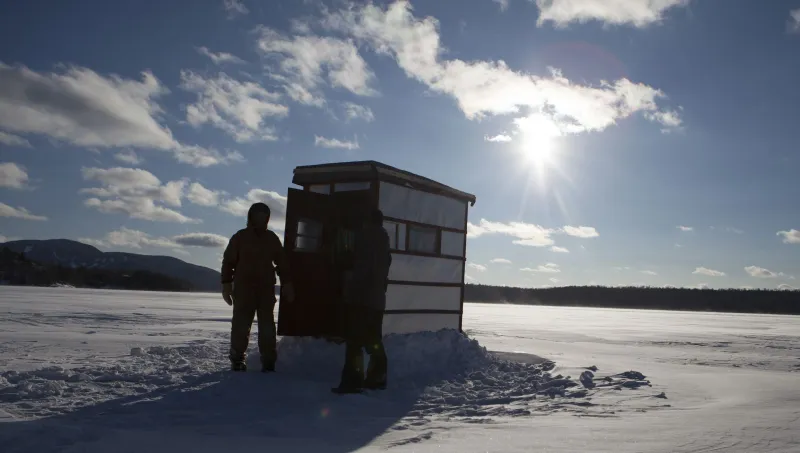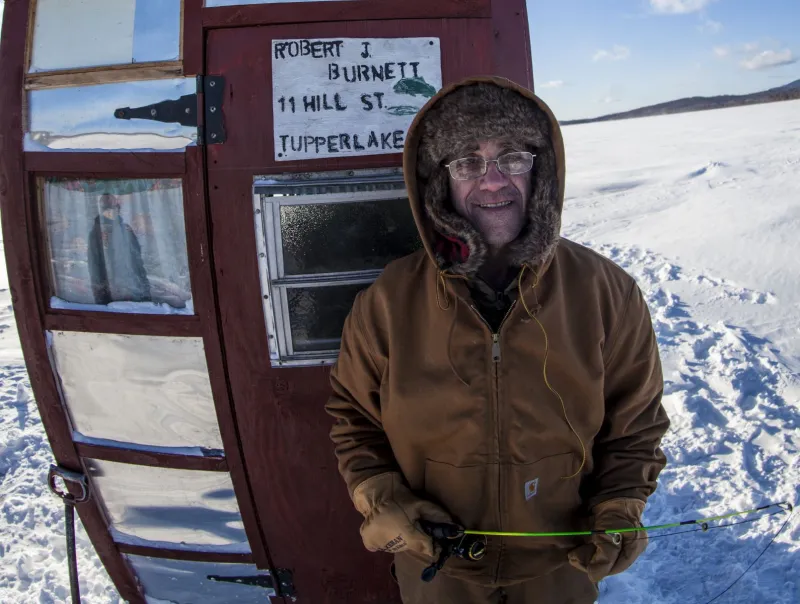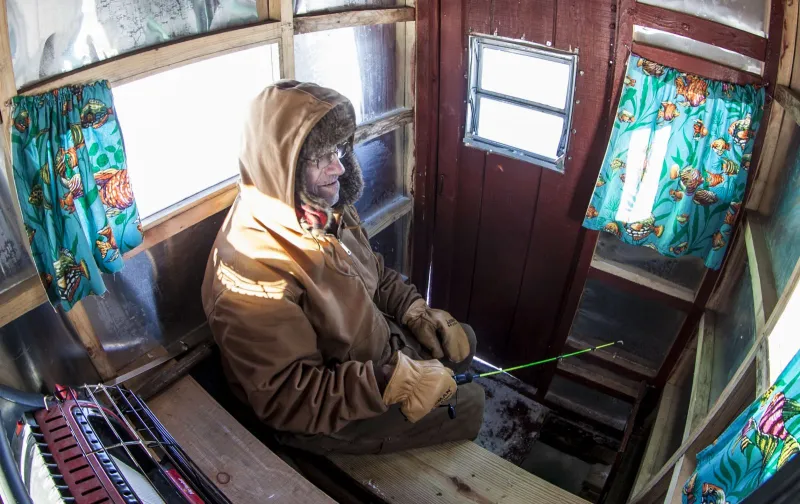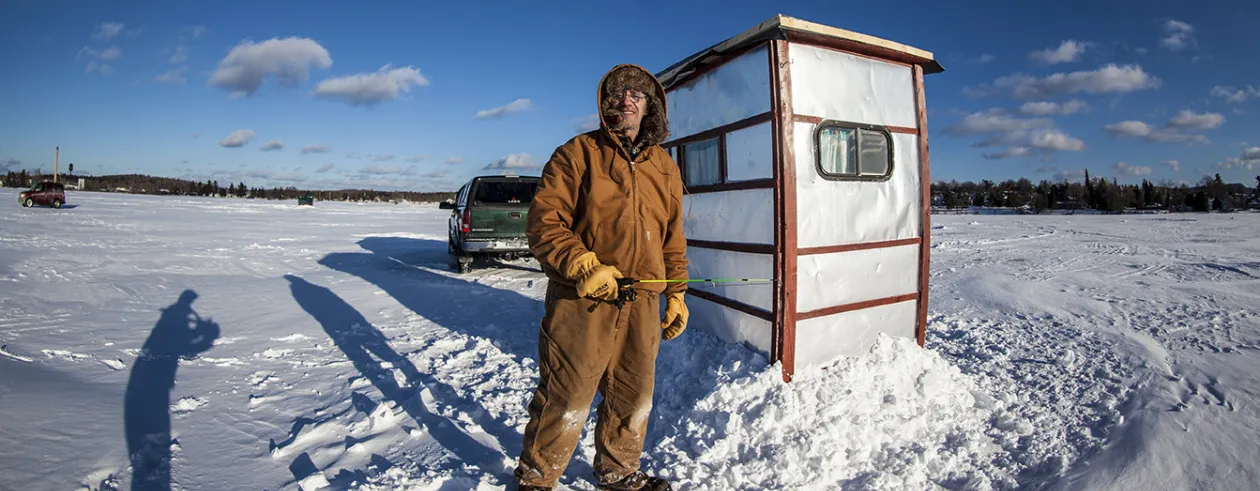
with a local fisherman
1.25.17 Editor's Update: With the Northern Challenge Ice Fishing Derby fast approaching, we thought we’d cast a line into the archives and discover a day in the life of an ice angler (originally published 2.10.2015).
Ice Fishing in the Adirondacks
Ice fishing has been a cherished pastime in Tupper Lake since the first settlers came to this unspoiled region more than a century-and-a-half ago. Chopping the ice with a long chisel or ax, they would wait with baited hand-lines for a tug before pulling in a silver-sided trout. Today, Tupper Lake remains at the center of this rewarding winter tradition, where throngs of local Adirondackers and visitors venture out for the thrill and the chill of a day on the ice. And for those who haven’t tried it, this region is a good place to start.

Get started!
Ice fishing is accessible to anybody with a jig pole, ice auger, and a New York State fishing license (although most tend to bring far more equipment.) It can be a social sport or a chance for solitude; a time to sit and think or an opportunity not to think at all. Some find it relaxing, while others say ice fishing helps keep them active and healthy. “Whether I catch perch or not, I’m getting my exercise,” says veteran ice fisherman Bob Burnette. “I’m 67 and my heart is still good so far, knock on wood.”

Setting up is a major part of ice fishing. The ambitious fisherman is out in the pre-dawn hours getting ready. For Bob that means lighting his propane heater and getting the chill off his homemade fishing shanty, pouring himself a hot cup of coffee and then busying himself setting up his tip-ups. Tip-ups are basically a spool of line attached to a stick that goes through the hole in the ice. It’s held in place by another stick that spans the top of the hole crosswise to form a “t”. When the fish takes the bait the rotation of the spool releases a spring-loaded flag. Once the tip-ups are all “set” it’s time to “hurry up and wait” as Bob likes to say. That means ice-skating, BBQs and beverages of choice. It means a good crank radio and a can of hot stew. It means a lot of different things to a lot of different people. But all these activities are punctuated by an alert glance up at the tip-ups, and every once in a while you’ll spring into action as a red flag pops up in the air.
“A flag!” you’ll yell, as you run over and slide in next to it like it was home plate. You see the line spooling out under the ice and carefully take out the tip-up and give the line a pull. The fish pulls back and gives a good fight, stripping line through your cold fingers. Eventually you draw it in and see it zigzagging past the hole. Is it a perch, a walleye or maybe a northern pike? Finally, you draw its head through and scoop out the fish and to your amazement it’s a beautiful native lake trout—a real prize.
Home away from home
For all-day ice fisherman like Bob, the sport can become very gear intensive. But for him bringing out a wagon train full of equipment is part of the fun. Once his shanty is set up he leaves it there for the season. Others carry a portable tent or shelter, a good idea when it’s cold and windy. A good heat source from a stove or propane heater and a gas powered auger to bore through the thick Adirondack ice are added luxuries. And don’t forget plenty of tip-ups, bait, food, drinks and extra warm cloths. Dressing properly is critical to an enjoyable and safe day on the ice. You’ll need warm clothes that break the wind, well-insulated boots, a neck gaiter or balaclava and the warmest gloves you can find.

There are a variety of ways to get all this stuff out there. Some go on foot pulling a pulk or sled, while others depend on snowmobiles or ATVs. Driving cars and trucks onto the ice is generally discouraged. Many lakes have currents and spring holes where it’s unsafe to drive. Extreme caution and local knowledge are essential to safe navigation over any frozen water body. Not all ice is created equal, according to Bob. The cloudy white ice with a lot of air mixed into it is soft ice and “not trustworthy.” But ice that’s formed during dry, cold winters, like we’ve had this year, produces a transparent blue ice that he says is very safe but “hard as horn” when trying to cut it. This year Bob says the ice on Raquette Pond is 18-inches thick. He says a gas auger is a must-have to power through it.
All in a day's work
You’d think all this work would all but guarantee to produce big catches, but it doesn’t. Sometimes not a fish will bite. Other times you can have three flags go off at once and not have enough hands to bring them in. Bob considers a couple dozen perch and a trio of pike a pretty good day. He likes to filet the perch, bread and fry them in a dish he calls “poor man’s shrimp.” But at the end of the day Bob says he has fun whether or not he’s caught fish, because “a bad day out fishing is still better than a good day at work.”
Try ice fishing in the Tupper Lake Region this winter and we'll bet you'll be back! Plan your trip now - figure out where to stay, then shop for your supplies and hit the lake, we'll see you soon!
Think you are up for the challenge? Come on out for the Northern Challenge Ice Fishing Derby on February 4, 2017 and join over 1,000+ anglers on Simon Pond as they compete for nearly $35,000 in cash and prizes.
This week in related ADK ice fishing news:
